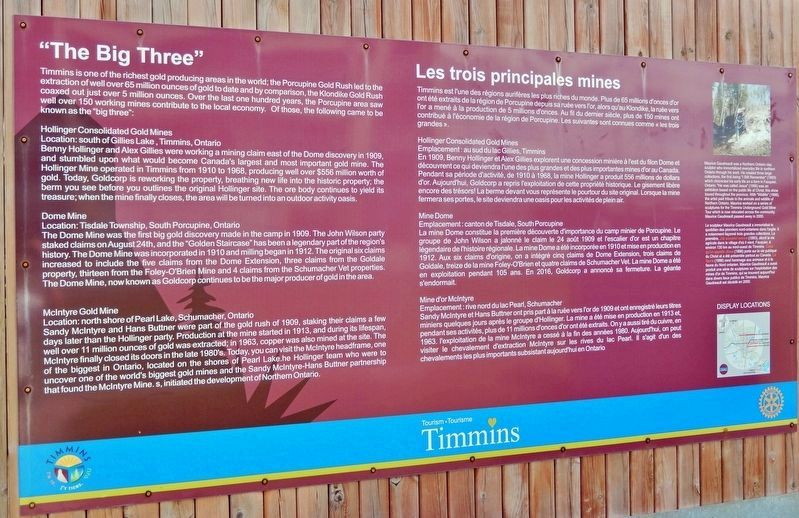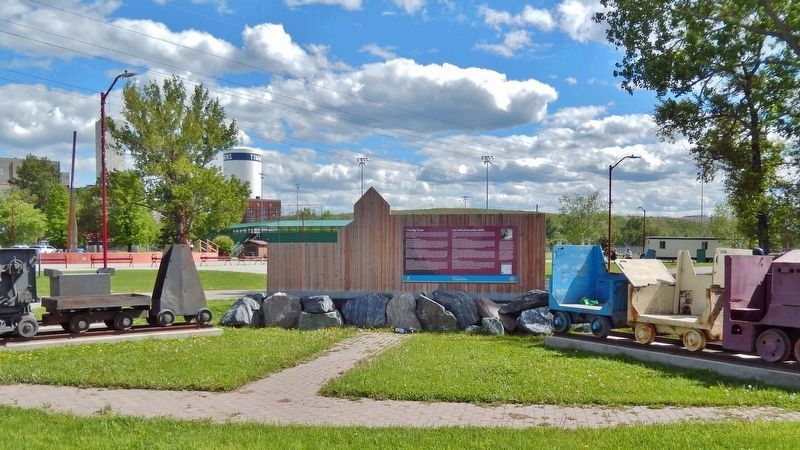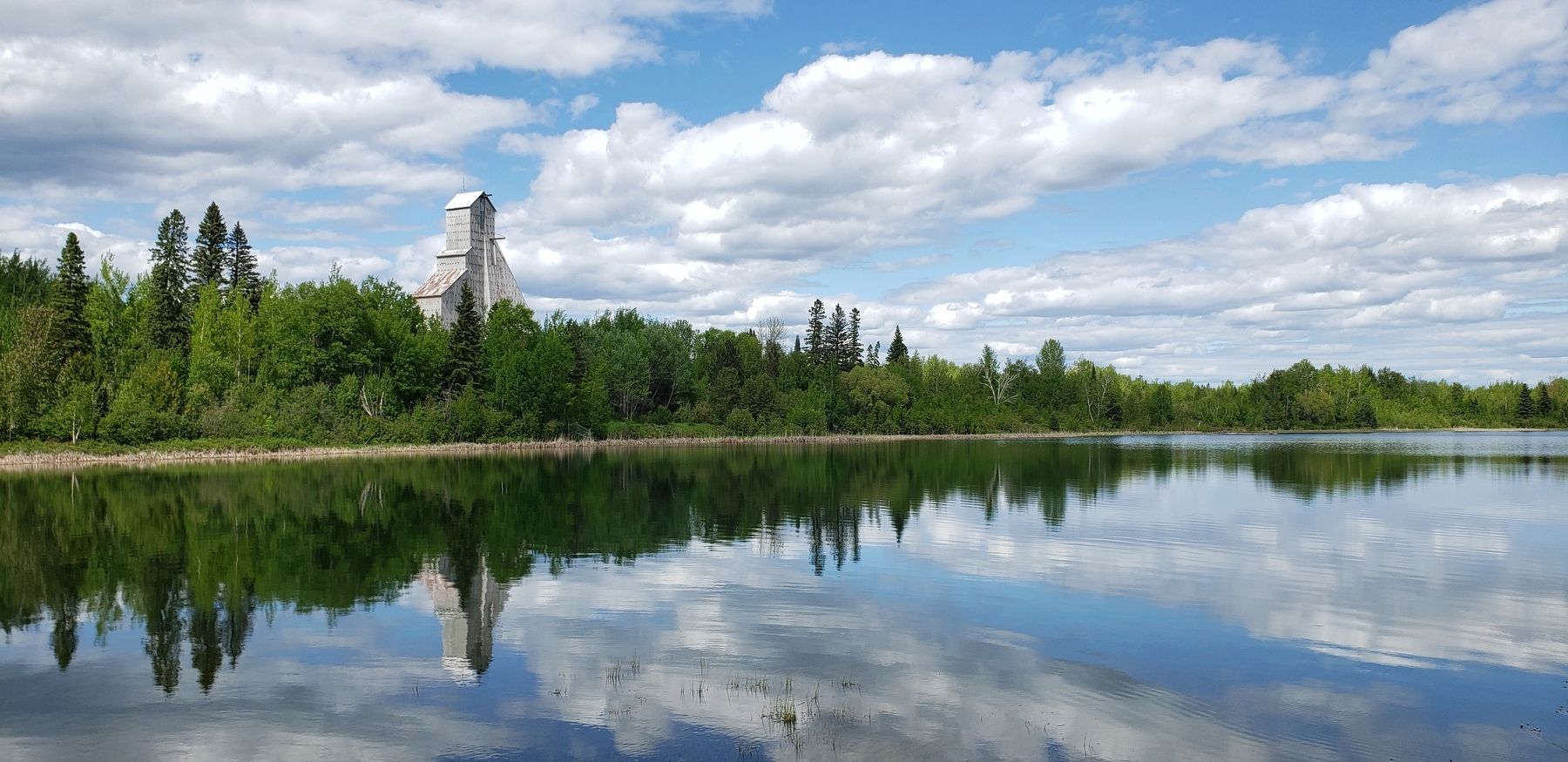Timmins in Cochrane District, Ontario — Central Canada (North America)
"The Big Three" / Les trois principales mines
Inscription.
Hollinger Consolidated Gold Mines
Location: south of Gillies Lake, Timmins, Ontario
Benny Hollinger and Alex Gillies were working a mining claim east of the Dome discovery in 1909, and stumbled upon what would become Canada's largest and most important gold mine. The Hollinger Mine operated in Timmins from 1910 to 1968, producing well over $556 million worth of gold. Today, Goldcorp is reworking the property, breathing new life into the historic property; the berm you see before you outlines the original Hollinger site. The ore body continues to yield its treasure; when the mine finally closes, the area will be turned into an outdoor activity oasis.
Dome Mine
Location: Tisdale Township, South Porcupine, Ontario
The Dome Mine was the first big gold discovery made in the camp in 1909. The John Wilson party staked claims on August 24th, and the "Golden Staircase" has been a legendary part of the region's history. The Dome Mine was incorporated in 1910 and milling began in 1912. The original six claims increased to include the five claims from the Dome Extension, three claims from the Goldale property, thirteen from the Foley-O'Brien Mine and 4 claims from the Schumacher Vet properties. The Dome Mine, now known as Goldcorp continues to be the major producer of gold in the area.
McIntyre Gold Mine
Location: north shore of Pearl Lake, Schumacher, Ontario
Sandy McIntyre and Hans Buttner were part of the gold rush of 1909, staking their claims a few days later than the Hollinger party. Production at the mine started in 1913, and during its lifespan, well over 11 million ounces of gold was extracted; in 1963, copper was also mined at the site. The McIntyre finally closed its doors in the late 1980's. Today, you can visit the McIntyre headframe, one of the biggest in Ontario, located on the shores of Pearl Lake. The Hollinger team who were to uncover one of the world's biggest gold mines and the Sandy McIntyre-Hans Buttner partnership that found the McIntyre Mines, initiated the development of Northern Ontario.
Maurice
Gaudreault was a Northern Ontario clay sculptor who immortalized everyday life in northern Ontario through his work. He created three large collections, the first being "I Still Remember" (1993) which chronicled his early life on a farm in Fauquier, Ontario. "He was called Jesus" (1996) was an exhibition based on the public life of Christ; this show toured throughout the province. With "Wildlife" (1998), the artist paid tribute to the animals and wildlife of Northern Ontario. Maurice worked on a series of sculptures for the Timmins Underground Gold Mine Tour which is now relocated across the community. Maurice Gaudreault passed away in 2000.
Hollinger Consolidated Gold Mines
Emplacement : au sud du lac Gillies, Timmins
En 1909, Benny Hollinger et Alex Gillies explorent une concession minière à l'est du filon Dome et découvrent ce qui deviendra l'une des plus grandes et des plus importantes mines d'or au Canada. Pendant
sa période d'activité, de 1910 à 1968, la mine Hollinger a produit 556 millions de dollars d'or. Aujourd'hui, Goldcorp a repris l'exploitation de cette propriété historique. Le gisement libère encore des trésors! La berme devant vous représente le pourtour du site original. Lorsque la mine fermera ses portes, le site deviendra une oasis pour les activités de plein air.
Mine Dome
Emplacement : canton de Tisdale, South Porcupine
La mine Dome constitue la première découverte d'importance du camp minier de Porcupine. Le groupe de John Wilson a jalonné le claim le 24 août 1909 et l'escalier d'or est un chapitre légendaire de l'histoire régionale. La mine Dome a été incorporée en 1910 et mise en production en 1912. Aux six claims d'origine, on a intégré cinq claims de Dome Extension, trois claims de Goldale, treize de la mine Foley-O'Brien et quatre claims de Schumacher Vet. La mine Dome a été en exploitation pendant 105 ans. En 2016, Goldcorp a annoncé sa fermeture. La géante s'endormait.
Mine d'or McIntyre
Emplacement : rive nord du lac Pearl, Schumacher
Sandy McIntyre et Hans Buttner ont pris part à la ruée vers l'or de 1909 et ont enregistré leurs titres miniers quelques jours après le groupe d'Hollinger. La mine a été mise en production en 1913 et, pendant ses activités, plus de 11 millions d'onces d'or ont été extraits. On y a aussi tiré du cuivre, en 1963. l'exploitation de la mine McIntyre a cessé à la fin des années 1980. Aujourd'hui, on peut visiter le chevalement d'extraction McIntyre sur les rives du lac Pearl. Il s'agit d'un des chevalements les plus importants subsistant aujourd'hui en Ontario.
Le sculpteur Maurice Gaudreault a immortalisé le quotidien des pionniers nord-ontariens dans l'argile. Il a notamment façonné trois grandes collections. La première, J’ai souvenir encore, (1993), décrit la vie agricole dans le village d'où il vient, Fauquier, à environ 130 km au nord-ouest de Timmins. Celui qu'on appelle Jésus (1996) porte sur la vie publique du Christ et a été présentée partout au Canada. La Faune (1998) rend hommage aux animaux et à la faune du Nord ontarien. Maurice Gaudreault a aussi produit une série de sculptures sur l'exploitation des mines d'or de Timmins, qui se trouvent aujourd'hui dans divers lieux publics de Timmins. Maurice Gaudreault est décédé en 2000.
Erected by Timmins Tourism and Rotary Club International.
Topics and series. This historical marker is listed in these topic lists: Arts, Letters, Music • Industry & Commerce • Parks & Recreational Areas • Settlements & Settlers. In addition, it is included in the Rotary International series list. A significant historical year for this entry is 1909.
Location. 48° 28.594′ N, 81° 19.227′ W. Marker is in Timmins, Ontario, in Cochrane District. Marker is on Algonquin Boulevard East (Provincial Highway 101) just east of Brunette Road, on the right when traveling east. The marker is located on the north side of Hollinger Park. Touch for map. Marker is at or near this postal address: 565 Algonquin Boulevard East, Timmins ON P4N 1B7, Canada. Touch for directions.
Other nearby markers. At least 8 other markers are within 10 kilometers of this marker, measured as the crow flies. Shania Twain (approx. half a kilometer away); Gold Mining in Canada / Production de l'or au Canada (approx. 0.6 kilometers away); Ore From the Kidd Creek Mine (approx. 1.6 kilometers away); The Porcupine Gold Rush / La Ruée vers l'or de Porcupine (approx. 2 kilometers away); CFCL Radio / Station de radio CFCL (approx. 2.4 kilometers away); The Gold Seekers / Les chercheurs d'or (approx. 8.1 kilometers away); Tisdale Township Municipal Building (approx. 8.1 kilometers away); The Porcupine Fire / L'incendie de Porcupine (approx. 8.6 kilometers away). Touch for a list and map of all markers in Timmins.
Related markers. Click here for a list of markers that are related to this marker. Timmins Heritage Tour
Also see . . .
1. Hollinger Mines (Wikipedia). Excerpt:
The Hollinger Gold Mine was discovered on October 9, 1909, by Benny Hollinger, who found the gold-bearing quartz dike that later became known as Hollinger Mines. Hollinger and Gillies staked three claims each, and one for their former partner, Bernard "Barney" P. McEnaney, who had been unable to join them due to severe sciatica.(Submitted on April 6, 2024, by Cosmos Mariner of Cape Canaveral, Florida.)
2. Dome Mine (Wikipedia). Excerpt:
Dome Mine was developed during the Porcupine Gold Rush. Last operated by Canadian company Goldcorp, before it became a subsidiary of American company Newmont, it is one of three mines (along with Hoyle Pond underground and Hollinger Open Pit, both still active) owned by Newmont in the Porcupine district in and around Timmins.(Submitted on April 6, 2024, by Cosmos Mariner of Cape Canaveral, Florida.)
3. McIntyre Mines (Wikipedia). Excerpt:
The McIntyre mine is an abandoned underground gold mine in Schumacher, Ontario, Canada, which has earned a place in Canadian mining history as one of the nation's most important mines. Its iconic headframe, located near downtown Timmins, has come to represent the entire Porcupine Gold Rush. The McIntyre also yielded a considerable amount of copper over its life.(Submitted on April 6, 2024, by Cosmos Mariner of Cape Canaveral, Florida.)
4. Maurice Gaudreault (1932–2000). Excerpt:
(English translation) At 14, like many young people of his generation, Maurice left school to go to the construction site and pursue a thousand and one trades. In the early 1980s, Maurice Gaudreault became an artist in residence at the Kapuskasing Recreation Center. This artist immortalized the history of the pioneers of Northern Ontario using the medium he loved and knew best: clay. (Paul-François Sylvestre)(Submitted on April 6, 2024, by Cosmos Mariner of Cape Canaveral, Florida.)“Maurice often told me that he wrote the history of Northern Ontario in his own way and that he wanted young people to remember the past.” As I recount in the book I wrote in 2002 entitled Maurice Gaudreault, a sculptor of stories, Maurice was, in my opinion, a pioneer in the art of telling the story of our ancestors. He did not resort to words or literature. He used the material he particularly liked: earth! (Stéphane Laberge)
Credits. This page was last revised on April 6, 2024. It was originally submitted on April 6, 2024, by Cosmos Mariner of Cape Canaveral, Florida. This page has been viewed 46 times since then. Photos: 1, 2, 3. submitted on April 6, 2024, by Cosmos Mariner of Cape Canaveral, Florida.


